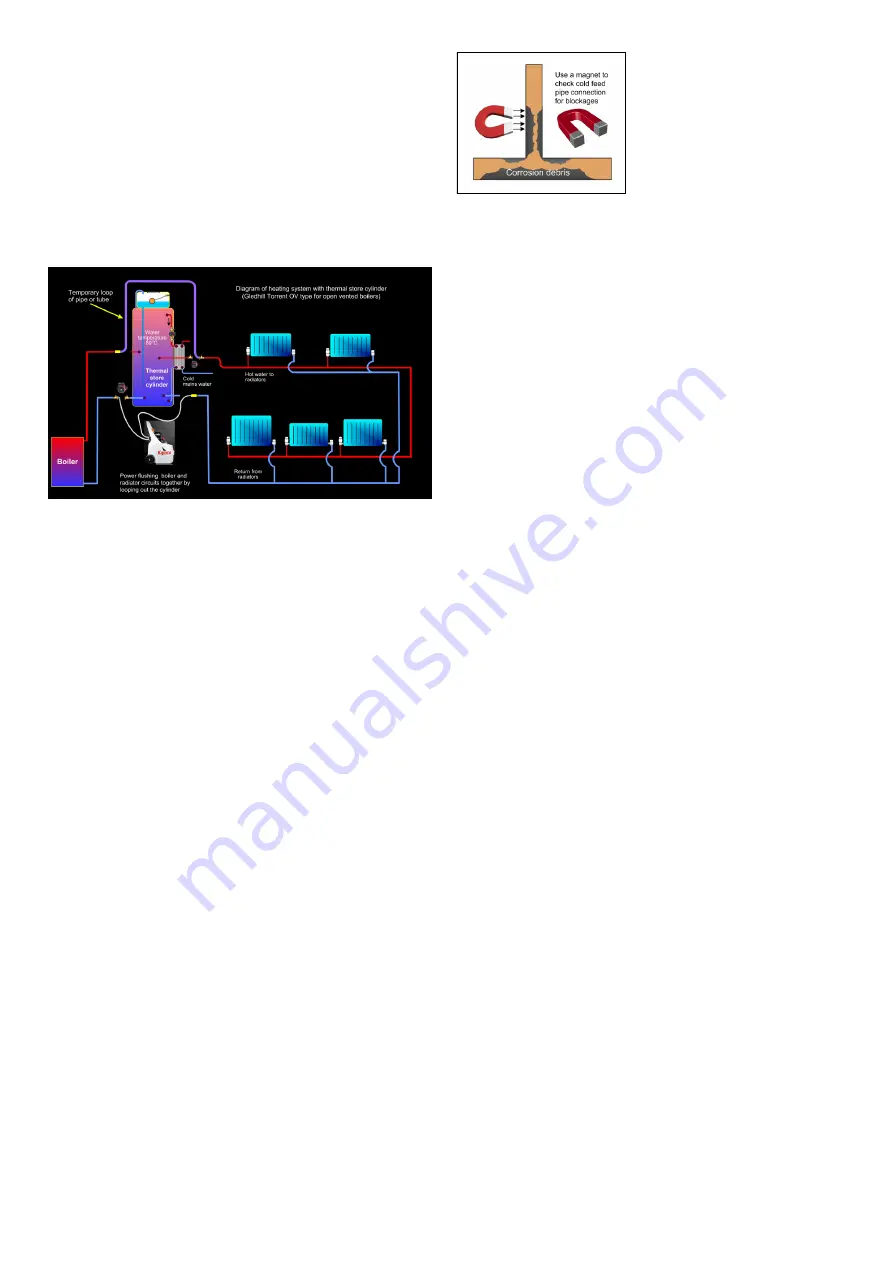
if you want to clean a heating system.
3. Another way to power flush a heating system with a
thermal store, again without including the cylinder and
contents in the power flush, is to loop the cylinder out,
so that the power flush pump is only connected in once,
and the boiler and radiator circuits are flushed just as for
a more conventional heating system.
See the following diagram for how to do this:
Things that might concern you
Q. Can you over pressurise a system, causing joints to
leak?
A. No. All Kamco Clearflow pumps are centrifugal type
pumps. What water they can’t push through a system
will simply re-circulate in the tank. Maximum pressure
is less than two bars. It is the flow rate through a system
that is important when power flushing.
Q. Any problems with thermostatic valves (TRVs)?
A. Generally, no, even with older TRV’s which should
only be fitted on the water inlet side of a radiator. Some
thermostatic valves may stick down, or act as non return
valves, so set them on ‘MAX’, and remove the valve
heads. Push down on the sprung pin a few times to
ensure that valve is fully open.
Things to check before you start
Q. The location where the cold feed and expansion
pipes join a vented system is often a problem area with
a lot of compacted debris. Can you tell if the cold feed
pipe is blocked, without cutting into the pipe work?
A. Not conclusively, but try holding a small magnet
against the outside of the copper pipe.
Copper isn’t magnetic, and so if you feel the magnet
being pulled onto the pipe, that tells you that there’s a
lot of magnetic iron oxide based debris in there. If it’s
completely blocked you will
have to cut the pipe work
section out. Start cutting!
Q. Is there is another way to check if a cold feed pipe is
blocked?
A. When starting to set up for a power flush, you’ll
normally cap off the cold feed and expansion pipes
before anything else. Don’t!
Just cap the expansion pipe only and leave the cold feed
‘open’. Now get your power flushing pump connected in
downstairs, with the isolating valves closed (as is normal
until you are ready to start the power flush). Open the
isolating valves without switching the pump on.
Because the pump isn’t running, theoretically, water
should start draining from the system into your pump
tank, under gravity.
If that doesn’t happen, the reason will be a blocked cold
feed pipe. Cut it out!
Chemicals to use
Q. Can I use Powerflush FX2 liquid on a system with
aluminium radiators, or an aluminium heat exchanger
such as found on condensing boilers?
A. No. We recommend that systems which include
aluminium are treated with HYPER-FLUSH, ideally several
days beforehand. You could then power flush the system
with water alone, but for the best result we recommend
that you use another pack of Hyper-Flush Concentrate as
you carry out the power flush.
Q. Why can’t I leave PowerFlush FX2 in a system, or pre-
treat a system with FX2?
A. We advise against leaving PowerFlush FX2 in
systems for a period of time BECAUSE it is a very
powerful flushing chemical. A contributing factor to its
performance is that it has a low pH, i.e. it is acidic.
It does contain special inhibitors in the formulation to
prevent corrosion of the system during the power flush,
and these inhibitors are very effective.
However, if you left PowerFlush FX2 in a system for
too long, then these special organic inhibitors would
gradually break down, and become less effective, and
some corrosion could take place.
This is not a problem during the course of a power flush,
and if FX2 were left in a reasonably sound heating system
Page 6




































